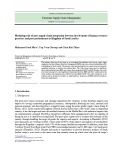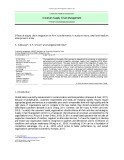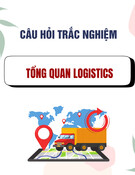
* Corresponding author
E-mail address:setyadi@mercubuana.ac.id (A. Setyadi)
© 2019 by the authors; licensee Growing Science, Canada
doi: 10.5267/j.uscm.2018.10.012
Uncertain Supply Chain Management 7 (2019) 121–132
Contents lists available at GrowingScience
Uncertain Supply Chain Management
homepage: www.GrowingScience.com/uscm
Does green supply chain integration contribute towards sustainable performance?
Antonius Setyadia*
aPost Graduate of Management, Universitas Mercu Buana, Jakarta, Indonesia
C H R O N I C L E A B S T R A C T
Article history:
Received September 20, 2018
Accepted October 30 2018
Available online
October 30 2018
Turning the attention towards a net performance of the Indonesian oil and gas industry is
important. Inconsistent performance of the oil and gas industry has shown the negative
consequence for the nation’s economy. However, up to some extent, the issues can be resolved
through green supply chain integration. Therefore, the ultimate purpose of this study is to
investigate the role of green supply chain integration on the sustainable performance of the oil
and gas industry of Indonesia. To collect the data, a survey questionnaire was used, and
questionnaires were distributed among the employees of oil and gas companies in Indonesia.
From total three hundred (300) distributed questionnaires, two hundred and one (201) were
returned and used to analyze the data through Smart PLS 3. Findings reveal that green supply
chain activities had a positive contribution in sustainable performance among oil and gas
companies. Supplier integration, customer integration and technological integration had a
substantial impact on economic sustainable performance and environmentally sustainable
performance. Thus, the Indonesian oil and gas companies are recommended to use green supply
chain activities to enhance performance.
Canadaensee Growin
g
Science,
by
the authors; lic9© 201
Keywords:
Green supply chain
Supplier integration
Customer integration
Technological integration
Economic sustainable
performance
Environmental sustainable
performance
1. Introduction
Turning the attention towards a net performance of the Indonesian energy market is a broader area. It
is estimated that Indonesia is one of the countries which is going to become a net importer of energy in
financial terms. This is happened due to the continual subdued thermal coal prices, increasing
investigated oil consumption fueled through different wasteful subsidies, and stagnating oil and gas
output. More specifically, if Indonesia follows a path of industrial growth and development, it is
estimated that Indonesian energy requirements will continue to increase, increasing from a projected
US$100b in 2012 to US$190b in five years. Additionally, in case of the production side, oil output
seems continues to slide and estimated that 20% shortfall of Indonesia's elusive 1 million barrels per
day approximately target with less than ten years' reserves and flat gas production (CLSA estimates
2017). Fig. 1 shows Indonesian imports in oil and gas sector in 2018. It depicts that imports are
increasing which is not a good sign for oil and gas industry.

122
Fig. 1. Indonesian Imports in Oil and Gas Sector
Source: Statistics Indonesia (2018)
Thus, the condition is threatening for Indonesia oil and gas industry. This downfall has negative
consequences on the economy of Indonesia. As the oil and gas have significant contribution in the
economic sector of every country (Oboh & Ajibolade, 2017). The energy sector is a significant
ingredient to all sectors of the nation's economy including agriculture, telecommunication,
transportation, and other industrial activities. This sector has a reasonable economic impact on each
country (Kinnaman, 2011; Castorena, et al. 2014; Dim & Ezeabasili, 2015; Jaya & Verawaty 2015;
Angbre, 2016; Tanoos, 2017; Chowdhury, et al. 2018).
Oil and gas sector has also the contribution in the gross-domestic-product (GDP). As it has a significant
impact to provide various opportunities related to employment which has a GDP contribution. It is
generally referred to as value-added which also includes income from labor and government revenues
contribution. In other cases, it has an indirect effect which is based on the impact on various industries
that deliver goods as well as services to the oil and gas industry. Hence, the oil and gas industry has
central importance for the economy of the country (Ariweriokuma, 2001; Sagers et al., 1995; Duru &
Chibo, 2014; Wang & Lu, 2016; Nazal, 2017; Taqi et al., 2018).
Therefore, Indonesia needs to adopt various strategies to ensure the recovery of the oil and gas sector
to boost economic contribution. Energy is one of the essential needs of every country which is
increasing day by day; thus, the significant intention must be paid to boost up this sector. This study is
one of the attempts to address the issues of Indonesian oil and, gas sector and emphasized on sustainable
performance with the help of green supply chain integration. Green supply chain integration has the
ability to enhance sustainable performance by increasing economic sustainable performance and
environmentally sustainable performance (Purnama, 2014; Solomon, et al. 2014; Suheil, 2015; Nze,
et al. 2016; Kimengsi & Gwan, 2017; Gebremeskel, et al. 2018). Therefore, Indonesia can enhance the
performance of the oil and gas sector with the help of green supply chain integration.
Green supply chain integration majorly includes supplier integration, customer integration and
technology integration. Supplier generally refers to a body that delivers materials, services, parts and
various goods straight to a concerned manufacturer (Russell & Taylor-III, 2008; Slack et al., 2010).
The customer is a body that accepts or consumes products, services as well as goods and has the
capability to select between various products and suppliers (Nurhaida et al., 2017; Slack et al., 2010).
In the case of a supply chain, consumer comprises of merchandiser, online retailer and wholesaler
(Russell & Taylor-III, 2008). Finally, the third element of green supply chain integration is
technological integration. Technology integration is an environmental exercise of the utilisation of
technology instruments taking place between a supplying and buying firms concerning actions such as
0
100
200
300
400
500
600
700
800
01234567
Imports ('000mt)

A. Setyadi / Uncertain Supply Chain Management 7 (2019)
123
product development procedure, a various process of re-engineering as well as technical training (Wu,
2013).
Therefore, the ultimate purpose of this study is to investigate the role of green supply chain integration
on the sustainable performance of the oil and gas section of Indonesia. In this study, three major
elements of green supply chain integration (supplier integration, customer integration, technology
integration) were taken as independent variables. Moreover, the oil and gas sector sustainable
performance were measured based on economic sustainable performance and environmentally
sustainable performance.
Green Supply Chain Sustainable
Integration (GSCI) Performance
Fig. 2. The theoretical framework of the study showing that how green supply chain integration
promotes sustainable performance
This study explores the role of green supply chain integration by considering the oil and gas sector of
Indonesia. To the best knowledge of the author, this is one of the rare studies which investigated the
effect of green supply chain integration on the sustainable performance of the oil and gas industry,
particularly in Indonesia. Therefore, this study is beneficial for oil and gas companies to focus on green
supply chain integration to enhance the overall performance.
2. Literature Review
2.1 Green Supply Chain Management (GSCM)
GSCM can be defined as “carrying products as well as services from suppliers, different manufacturers
to customers with the help of information flow, material flow, and transactions of cash flow in the
setting of environment” (Zhu & Cote, 2004; Zhu, Geng, & Lai, 2010; Zhu & Sarkis, 2007; Zhu, Sarkis,
Cordeiro, & Lai, 2008). Moreover, Srivastava (2007) explained, GSCM is thinking about
environmental into different supply-chain activities which consist of product design, various material
sourcing, selection of sources, manufacturing procedures and ending product delivery to the users.
Based on the different regulatory necessities and intense customers pressures, the scope of GSCM
started from monitoring of the overall environmental administration to more proactive activities applied
through different reverse logistic activities including recycle, refurbish, remanufacture, re-use, and
rework. The GSCM is shown in Fig. 3. The green supply chain is based on environment-friendly
customers, suppliers, purchases, warehouses, packaging, manufacturing, transportation and whole
green design in which all stakeholders support the environment.
Supplier
Integration
Customer
Integration
Technology
Integration
Supply Chain Operational
Capability
Economic
Sustainable
Performance
Environmental
Sustainable
Performance

124
Fig. 3. Green Supply Chain Management
The GSCM has increased intention for practitioners and academic researchers about efficiently
managing supply chain activities. The developing significance of GSCM is driven fundamentally
because it is environment-friendly, for example, expanding levels of contamination, flooding waste
destinations, and reducing crude material assets. In any case, it is not limited to the environment; it is
about great marketing prudence and higher profits. Indeed, it is a business esteem driver and not a cost
focus (Wilkerson, 2005). Since manufacturing organizations have regularly been charged for the
liabilities of environmental of their suppliers (Rao, 2008). There has been a significant interest to
incorporate environmental activities, inside the boundaries of the organization, as well as over the
whole supply chain including all supply chain partners to safeguard the company's sustainable
performance (Cote et al., 2008).
The green supply chain has many benefits including financial benefits, environmental benefits and
social benefits. Financial benefits include; increase in revenue, reduction in overall cost, increase in
asset utilization and enhanced customer services. However, the financial benefits can be disturbed
through political influence on stock returns (Maqbool et al., 2018). The environmental benefits include;
reduction of waste material, increase in the efficiency of energy, reduce in air emission, reduce in water
emission and reduction in fuel consumption which automatically enhance the sustainable performance.
Moreover, social benefits include, reduce community impact, noise reduction, traffic congestion
avoidance, health safety and improvement in securities. All the benefits of the green supply chain have
a considerable effect on overall economic sustainable performance and environmentally sustainable
performance among Indonesian oil and gas companies by increasing the operational capabilities which
have significant contribution in sustainable performance. An increase on the quality of economic and
environmental performance through the help of supply chain operational capabilities will also increase
the sustainable performance of companies (Schaltegger & Wagner, 2017). Moreover, open-innovation
capabilities through external knowledge (Hameed et al., 2018) and better investment decision making
(Hameed et al., 2018) in the supply chain can be influential to boost green supply chain. However, the
element of enterprise risk management cannot be neglected (Hameed et al., 2017).
2.2 Green Supply Chain Management (GSCM) and Sustainable Performance
Business sustainable performance is developed when an organization generates constant value for its
stakeholders by strictly following the environmental requirement (Brent & Labuschagne, 2004). Firm's
sustainable value has a few important features which are; environmental protection and society, and
more significantly by making the customer as well as shareholders happy. According to Dunphy (2011),
GREEN
SCM
Green
Design
Green
Supplier
Green
Manufacturing
Green
Warehouse
Green
Transport
Green
Customers

A. Setyadi / Uncertain Supply Chain Management 7 (2019)
125
“sustainability contains activities that spread socially appropriate lives of companies, enhance the
ability to maintain and restart the survival of the biosphere and also to befriend all living species,
increasing the ability of the community to uphold itself. In addition, sustainability can track its main
problems and to maintain the welfare, participation and autonomy of the present and future generations
of humanity”. However, this study is concerned with economic and environmental sustainable
performance.
According to Green Jr et al. (2012), economic sustainable performance is based on the assessment of
firm cost reduction, market shares contribution, increase in return on assets, increase in income, and
increase in profits margins concerning the economic objectives of performance (Green Jr et al., 2012).
GSCM always have a significant positive effect on economic performance (Liu et al., 2012) through
supply chain operational capabilities.
On the other hand, environmental concerns are driving business organizations to consider various
operational impacts. According to Junquera et al. (2012), environmental sustainable performance can
be defined as the assessment of firm reduction for emissions of harmful elements, reduction of
utilization for dangerous or destructive materials, and well-organized energy use. Achievement of
environmentally sustainable growth can be attained through a reduction in different resources
utilization such as reduction in waste generated material and any other harmful resources (Brent &
Labuschagne, 2004).
The business firms have an immense obligation socially where they have to deal with their employees
and social orders. Teraji (2009) characterized social sustainable performance as an assessment of
association on the solid workplace, social responsibility and investment, education, and human
resources advancement. He concluded that as mindfulness among consumers on corporate social
performance expands, management progressively perceives their duties regarding actualizing ethical
projects to upgrade social welfare. There are several domains, namely; human resources, corporate
governance, human rights, and environment that ought to be legitimately surveyed (Bessire & Onnée,
2010; Komalasari & Suryanto, 2017; Suryanto & Grima, 2018). Environmental performance is also
based on social sustainable performance.
Past investigations (Vachon & Klassen, 2006; Zhu et al., 2010) have demonstrated that supplier
integration is emphatically identified with firm sustainable performance. Vachon and Klassen (2006)
have discovered that collaboration with suppliers could enhance sustainable performance of one
association economically and second environmentally. Creating collaborative association with
suppliers is additionally positive for a successful selection, advancement, and usage of the GSCM
toward social commitments (Vachon, 2007).
The customer is an individual that utilizes or consumes products (goods or services) and can pick
between various products and suppliers (Slack et al., 2010). In the supply chain, a customer consists of
wholesaler incorporates merchandiser, consumers and retailer (Russell & Taylor-III, 2008).
Coordinating customer from the GSCM point of view can be characterized as “environmental
communication between a principal company and its different customers that plan to satisfy
environmental prerequisites related to the customer” (Vachon & Klassen, 2008). It centers about the
downstream side of the various supply chain activities. Customer integration handles the level of
integration in receiving green supply chain practices for environmental handling, arranging purposes,
and to discover arrangements of environmental issues (Wu, 2013).
Huber et al. (2007) demonstrated that the utilization of technology in the supply chain adds to successful
correspondence with operations. A plenty of innovations having customer driven highlights and data
concentrated give massive advantages like cost reduction process, increased flexibility, and increase in
coordination (Andiç et al., 2012). The technology integration in green supply chain management ought
to have the capacity to help the advancement of green activities prepared in an organization, which
naturally expands the likelihood to accomplish environmental objectives. In any case, the technology











![Sổ tay Hướng dẫn phát triển chuỗi cung ứng [Chuẩn nhất]](https://cdn.tailieu.vn/images/document/thumbnail/2025/20251007/kimphuong1001/135x160/26201759828896.jpg)

![Bài giảng Logistic: Kho công cộng [Chuẩn Nhất]](https://cdn.tailieu.vn/images/document/thumbnail/2025/20250926/duyaokij2004@gmail.com/135x160/37761759129622.jpg)



![Bài giảng Mô hình và thiết kế hệ thống Logistics [chuẩn nhất]](https://cdn.tailieu.vn/images/document/thumbnail/2025/20250919/kimphuong1001/135x160/30911758252266.jpg)

![Trắc nghiệm nghiệp vụ giao nhận và khai báo hải quan [mới nhất 2024]](https://cdn.tailieu.vn/images/document/thumbnail/2025/20250916/dngapr1187/135x160/69491758016420.jpg)

![Bài giảng quản lý chuỗi cung ứng: Cung ứng và mua hàng [chuẩn nhất]](https://cdn.tailieu.vn/images/document/thumbnail/2025/20250915/nguyendinhdanhbgg2005@gmail.com/135x160/67081757989489.jpg)
![Đề thi Quản trị Logistics và chuỗi cung ứng quốc tế học kì 2 năm 2024-2025 có đáp án [Mới nhất]](https://cdn.tailieu.vn/images/document/thumbnail/2025/20250915/kimphuong1001/135x160/59591757927414.jpg)



